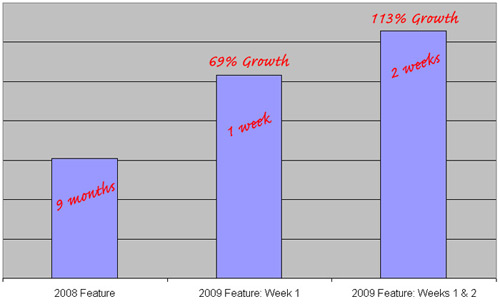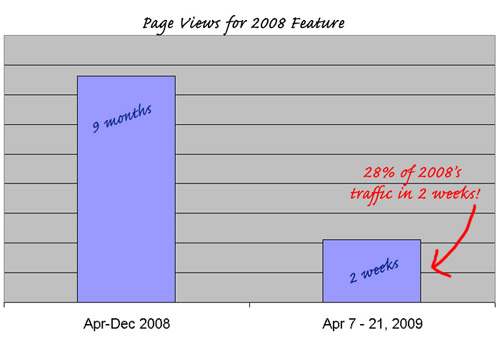Not a 2009 Top Restaurant – Gray’s Papaya. I guess my vote didn’t count.
Recently I have written a lot about our efforts here at Reed Business Information to increase online performance around print features that are brought online. So far, I have presented three mini case studies:
- Library Journal’s Salary Survey Feature: 1,200% page view growth
- Library Journal’s e-Reference Ratings Feature: 730% page view growth
- Library Journal’s Star Library Feature: off the charts growth
I want to share a fourth case study, and for all you loud-talkers, you will be happy to hear it has nothing to do with libraries.
This time around, I had the privilege of working with Restaurants & Institutions, which covers all those tasty restaurants that I like to frequent and dream about. Each spring, R&I releases their listing of Top 100 Independent Restaurants, and this time around, the R&I team looked to approach it differently for the web. The goal: to better serve their readers, and increase online performance. The results so far:

So the growth is not as extreme as we saw with Library Journal, but this is still a huge growth rate for such a short period of time. There was also another little bonus… traffic to the previous year’s Top Restaurants feature received a big bump due to the editors including links to it in the 2009 feature.

All in all, this is great news. Here are some of the most important takeaways:
- Empower Each Team Member

I saw this when working with Library Journal, and see it again with the R&I staff: while there is typically a lead editor for a specific feature, each staffer was able to lend a hand in a specific way that highlighted their expertise, and gave them a role in online growth.I consider this one of our biggest challenges: It is one thing to have big goals, but it is another thing entirely for individual employees to understand how they can reasonably contribute towards that goal in a measurable way. So it’s nice to see these teams finding a way of working together on projects that are so positive.
This is also where the value of web analytics and measurement comes into play at well, as a nice reward for a job well done.
There is so much change going on, that editorial resources are being stretched and changed on a near daily basis. And let’s face it – that can be incredibly stressful, and actually take away from productivity.
But when the team comes together on a specific project – one that gives them a sense of control and ownership, suddenly all this change does the most important thing of all: enables them to execute on their goals of serving their industry.
- Have a Strategy

For the R&I feature, I worked with their editor-in-chief Kelly Killian to understand her goals, the intricacies of this feature, and the needs of her audience. We talked about possibilities and ideas, and formalized our plan well in advance of publication in order to have clear steps.As is often the case, there was no shortage of ideas, but without a clear plan and division of labor, it would be unlikely that we would have executed on even a tiny fraction of these ideas. It’s always a challenge to avoid focusing only on the tasks that are easiest or are most familiar, not those that will have the greatest return-on-investment.
- Create New Processes

Nobody likes change. An inherent part of projects like this is to analyze how things are done – take a fresh look at the goals – and come up with new processes that overcome challenges we are facing in meeting them.The first time around with this type of project is always messy, and quite frankly, that can be fun. But, it’s not fair to ask this of staff members on an ongoing basis. With each iteration, the trick is to be aware of which processes work, and which don’t.
The goal of all this change should be LESS stress, not more.
- Become a Marketer

One aspect of the R&I plan for this feature was to connect more directly with bloggers and other media outlets who might want to cover this news. They started small… talking about who to target, and which markets might be the most interested.Kelly came up with a simple list of 10 or so places to focus her attention. The most important step here was to do this before launch. In the craziness of launching a big feature like this, you don’t want to first be starting to dig up contact information for newspapers and bloggers.
The strategy she went with was to inform these sources of the news before it even launched – giving them a heads up so that they could prepare for the news if they felt it would be relevant to their readers. Kelly received positive feedback and interest prior to launch, and knew exactly who to contact once things went live.
The great thing about this is that she is establishing relationships that can be leverage more easily the next time around.
I really feel that only perhaps 70% of an editor’s job is done once an article is finished. Ensuring it reaches the intended audience, measuring its performance, and making changes based on what is learned is the 30% that can happen once an article is live.
- If You’re Not Measuring, How do You Know What’s Working?

The R&I team is like all editorial teams I work with: INCREDIBLY MOTIVATED, BUT INCREDIBLY BUSY. Kelly and I were sure to check in with each other each week or so to assess progress, identify anything that slipped through the cracks, and see if new opportunities came up.With so much to do, I know the temptation is to focus on whatever is on fire… but it is critical to measure benchmarks, set goals, and measure performance at several stages after launch. One week after the feature launched, we looked at the metrics, and discussed further opportunities. It became a fun process of creation, even after the feature launched – as the team looked for ways to extend interest in the feature a week or two after launch.
If you aren’t carefully looking at your performance metrics, and talking about strategy and tactics throughout the process of creating an online feature, then you might be missing opportunities, and focusing too many resources on the wrong things.
- Replicate What’s Working

Once you identify a product, service or process that does deliver growth, the next step is to see how you can replicate it as often as possible.R&I is mapping out their online editorial calendar for the rest of the year, and identifying which features will get a comparable treatment. They are also working to evolve the process – to identify which tactics brought them the most success, and which were nice ideas, but didn’t really work out as well as we hoped.
- Talk to Your Sales Team

We are finding success in attracting readers and growing engagement through strategies and tactics like these – but translating that to a sustainable revenue model is still challenging. I try to speak to publishers and the sales teams as often as I can, and I am always amazed at what I learn.We ALL need to come together to find these solutions to continue building a strong business. It is not enough to focus just one aspect of the business – I have seen editors contribute great ideas to salespeople, and salespeople contribute amazing ideas to editors. We’re on the same team here, and I think we all realize that the health of the business is critical for each of us meeting our personal goals. No matter what you are working on – no matter what your beat if you are an editor – you have an opportunity to assist in revenue growth.
For R&I and Library Journal, working on these features started great conversations with the sales teams, and they are now involved early and often.
With all of this, it is important to focus on the only thing that really matters: those you are serving. And that is a commitment that I see our editors and sales teams make every day.
Thanks so much to the R&I team!

